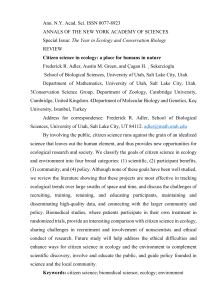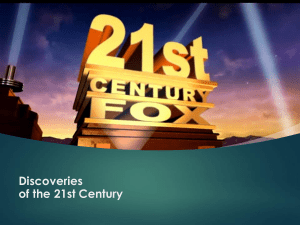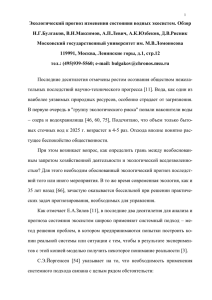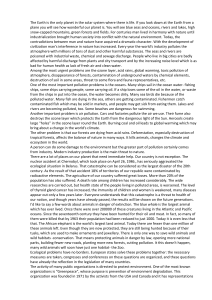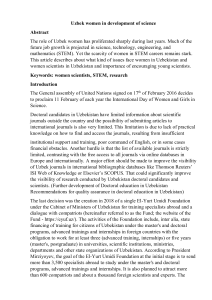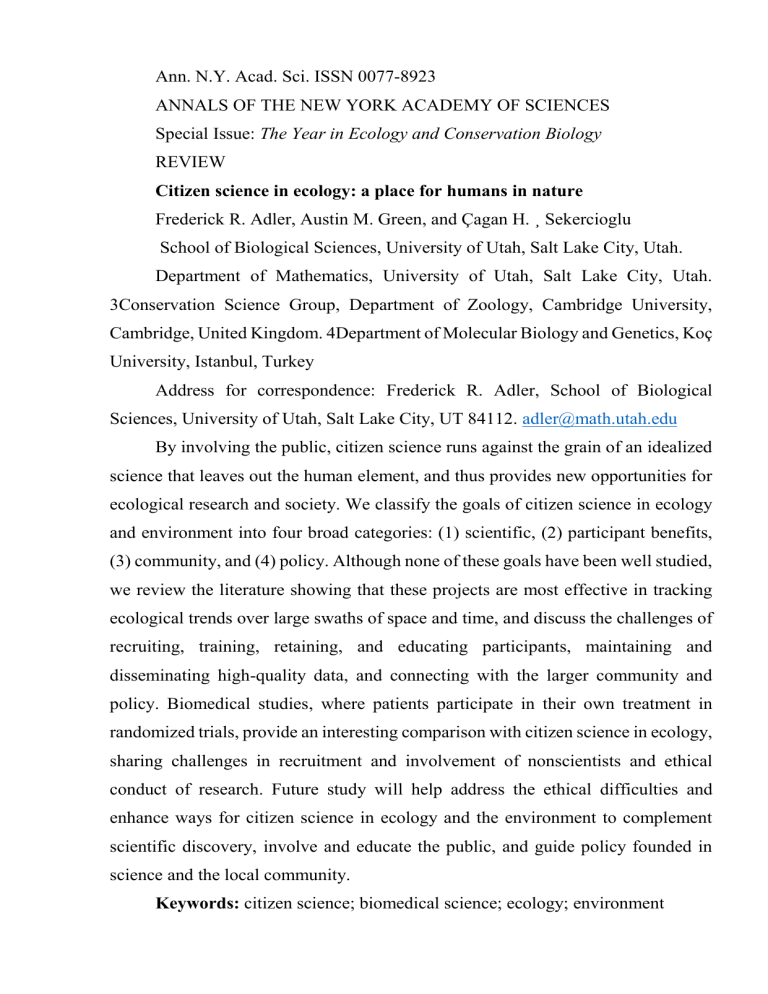
Ann. N.Y. Acad. Sci. ISSN 0077-8923 ANNALS OF THE NEW YORK ACADEMY OF SCIENCES Special Issue: The Year in Ecology and Conservation Biology REVIEW Citizen science in ecology: a place for humans in nature Frederick R. Adler, Austin M. Green, and Çagan H. ¸ Sekercioglu School of Biological Sciences, University of Utah, Salt Lake City, Utah. Department of Mathematics, University of Utah, Salt Lake City, Utah. 3Conservation Science Group, Department of Zoology, Cambridge University, Cambridge, United Kingdom. 4Department of Molecular Biology and Genetics, Koç University, Istanbul, Turkey Address for correspondence: Frederick R. Adler, School of Biological Sciences, University of Utah, Salt Lake City, UT 84112. adler@math.utah.edu By involving the public, citizen science runs against the grain of an idealized science that leaves out the human element, and thus provides new opportunities for ecological research and society. We classify the goals of citizen science in ecology and environment into four broad categories: (1) scientific, (2) participant benefits, (3) community, and (4) policy. Although none of these goals have been well studied, we review the literature showing that these projects are most effective in tracking ecological trends over large swaths of space and time, and discuss the challenges of recruiting, training, retaining, and educating participants, maintaining and disseminating high-quality data, and connecting with the larger community and policy. Biomedical studies, where patients participate in their own treatment in randomized trials, provide an interesting comparison with citizen science in ecology, sharing challenges in recruitment and involvement of nonscientists and ethical conduct of research. Future study will help address the ethical difficulties and enhance ways for citizen science in ecology and the environment to complement scientific discovery, involve and educate the public, and guide policy founded in science and the local community. Keywords: citizen science; biomedical science; ecology; environment Introduction In one ideal, science seeks as much as possible to remove the human element. Objectivity seeks to remove both values and preconceptions. The textbook version of hypothesis testing ignores the serendipity of observation and buries the human and societal biases in the questions we choose to ask. The scientist, like Dr. Frankenstein, works alone, turning to others as a respite from the rigors of investigation. Experts turn to nonexperts only as assistants, not as collaborators who could understand seemingly esoteric knowledge. In this ideal, studies of ecology seek out pristine nature, untouched by humans, to reveal the complex processes that shape the world around us. And the quest for truth should in no way be sullied by policy considerations or be confused with any sort of advocacy. This ideal, of course, has never existed, but it has been challenged by many currents in recent times. The rise of citizen science exemplifies many of these currents and breaks down every aspect of the inhuman ideal caricatured above. By definition, the scientist cannot work alone, and turns to others not for emotional support but for scientific assistance and insight into the larger implications of the research. The quest for truth is thus coupled with many other goals, including educating and involving people from diverse backgrounds, and treating those people ethically and respectfully. Many studies are observational, such as tracking the distribution and abundance of organisms, rather than testing a hypothesis, and the questions to be studied may arise not from the internal logic of scientific progress but from the concerns of participants. People live near other people and are concerned about the changes in the world we have created; citizen scientists have little access to the supposedly pristine. Finally, many, if not most, people who engage in ecological research do so precisely because of its policy implications and to advocate for specific actions Scientists and citizens who engage in ecological and environmental research sometimes conceptualize these policy concerns in terms of health: diagnosing and restoring an ecosystem. In the context of biomedical research, this parallel is more than a metaphor.9 Diagnosis and treatment in medicine require the participation of patients and their families, and the underlying science is built on medical research involving patient volunteers. In this paper, we use the commonalities and contrasts with biomedical research to cast new light on the assumptions we make about citizen science in ecology and the environment. Clinical research cannot be done without people, that is, patients, making the isolated ideal not only impossible but also absurd. This creates a series of ethical challenges addressed through best practices, such as informed consent. The high personal stakes for critically ill patients and their families place them in a position to shape research questions, a direction taken only rarely and recently. Both medical and ecological studies must find ways to recruit participants, share results, and maintain ethical standards. The challenges of ownership of data collected by citizen scientists have even higher stakes with patient data and samples taken from patients, as exemplified by the effectively immortal cells taken from cancer patient Henrietta Lacks without her knowledge. Because the goal of good health is universally accepted, there is little contention about crossing the line from science to advocacy. This universal agreement, however, breaks down when balancing between goals, such as duration and quality of life, or in goals where subjective values, like appearance, affect recommendations about losing weight. This review presents an overview of citizen science, primarily in ecology and conservation biology, framed by this perspective; citizen science fundamentally changes the way in which we conceptualize and engage in the scientific enterprise. We begin by summarizing the goals and scope of citizen science investigations, along with some of their successes and challenges, integrate with the analogy of biomedical research involving patients, and conclude with open areas of opportunity. Although this is not a systematic review of citizen science in the fields of ecology and biomedical research, we aim to provide an up-to-date synthesis of each, a novel perspective on how they are related, and a spur to future research to address knowledge gaps and critical challenges. An overview of citizen science The expansion of citizen science has resulted not only from changing views of science, but also from more pragmatic factors, primarily the rise of internet technologies that make data collection and sharing at large scales far more efficient, and because citizen scientists work as volunteers at low cost and sometimes with separate funding streams. Citizen science projects have been categorized in many ways, depending on the approach, goals, or system. For example, Bonney describes four categories: data collection, data processing, curriculum based, and community science. We here focus on the first of these goals, those where data are collected in the field, but potentially with multiple and sometimes conflicting goals. We classify citizen science data collection goals into four broad categories: (1) scientific, (2) participant benefits, (3) community, and (4) policy. For studies with significant data collection, we elaborate on the challenges of designing, implementing, sustaining, and following up the process so that future practitioners can make more informed decisions. Scientific goals Among scientific goals, citizen science is particularly effective at addressing ecological questions at large spatial and temporal scales that cannot be covered by a small team of investigators. By tracking ecosystems over time, citizen science can provide crucial baseline information on effects of global change and for identifying locations with both good and poor environmental health. Because citizen science projects can last far longer than any particular individual effort and cover far more ground, they are particularly effective in mapping the spatial distribution of species, their declines or increases, changes in species distribution as a result of climate change, and the spread of biological invasions at scales not attainable through more traditional methods. Although less focused on hypothesis testing, citizen science is effective at large-scale studies of habitat loss, range, and phenology shifts, and for tracking infectious disease and invasive species over large areas and long temporal extents. For example, citizen science has helped in studying kissing bugs, Triatominae, to assess the entomological risk of Chagas disease in Texas. Even when citizen science studies are not maintained continuously over long periods of time, the power to link long-term studies to historical amateur naturalist datasets can offer an exciting glimpse into the distant past, and modern comparisons provide a novel way of engaging citizen scientists and creating studies that encompass decades or centuries. These historical data provide a foundation for assessing species richness and occurrence across a landscape and for measuring the conservation status of rare and elusive species. For a range of historical and financial reasons, scientific studies often focus on particular sets of organisms, habitats, and regions. Citizen science projects are focused in Europe, North America, South Africa, India, and Australia24 and are rare in many developing countries. Nonetheless, citizen science has contributed to conservation on an international level, and is a burgeoning area of research. The match of citizen science with largescale studies of species’ distribution and population trends lends itself well to international research, as most species’ ranges do not follow political boundaries. Therefore, species conservation typically requires international cooperation and both local and regional support. Currently, most of this international work is done by large organizations. For example, the Earthwatch Institute, an international nonprofit organization specializing in ecological, citizen science–based research, has recruited and trained thousands of volunteers to participate in dozens of projects across 30 different countries. With over 600 million records, eBird, operated by the Cornell Lab of Ornithology, has become an international sensation for both amateur birding enthusiasts and professional ornithologists. Millions of checklists are uploaded from around the world each day, which is leading to peer-reviewed publications spanning large spatial scales and temporal extents. eBird checklists have been used to assess bird population trends in North America, with models for species with more than 10,000 uploaded checklists producing population trend estimates consistent with more formal assessments. eBird checklists have also been used to quantify spatiotemporal shifts in migration phenology as a function of average temperature, while eBird and similar countrylevel initiatives can provide critical data to model the effects of climate change on the distribution of birds and other organisms. Zooniverse is another collaboration, led by a single large organization, that crosses political boundaries and multiple independent research groups. Nearly, 70 different ecological citizen science projects housed in the Zooniverse span over 50 different countries and all seven continents. eMammal, an online citizen science platform built specifically for camera trapping projects, currently houses 110 different projects from 22 different countries. As is the case in most ecological research, citizen science initiatives are concentrated in developed and temperate countries. Operation Wallacea is one example of a volunteer-funded conservationand-research organization with a particular focus on the tropics; it focuses primarily on biodiversity monitoring across 14 counties, but also establishes collaborations with biologists with specific research questions. The relatively low number of international citizen science publications resulting from these projects s indicates many promising research opportunities. At a smaller scale, the matrix of private land ownership and political boundaries in urban areas creates challenges for citizen science, because people who have nothing directly to do with the study can interfere with the potentially intrusive aspects of science. Getting private landowners involved in research across a residential matrix remains a challenge, but building community through citizen science may offer a way to expand into understudied areas of private land. With the large pool of potential participants available in densely populated cities, urban ecosystems have great potential for the creation of citizen science projects. Successful projects include the Tucson Bird Count and Chicago Wildlife Watch. The strength of citizen science data in addressing questions in landscape ecology and climate change, as well as finding rare organisms, tracking animal dispersal and distribution, and assessing species population trends, is ripe to expand into urban, agricultural, and residential ecology across a gradient of wildland–urban interfaces. For example, citizen scientists can be effective in assessing animal populations on stretches of road not previously documented. Participant benefits The goals of scientists themselves are not restricted to expanding scientific knowledge and recognition, but extend to more human goals of leadership, education, and outreach. For participants, goals are similarly broad. Involvement in citizen science projects promotes engagement with scientists, learning of both science and the scientific method, and participant well-being. Evaluating the success in reaching these goals, however, remains spotty. One study of aerosols showed that people learn about their specific topic but was less clear whether they learn about the scientific process more broadly. Even online-based citizen science, where direct communication with professional scientists and experts is minimal and educational resources may be sparse, has been shown to lead to increases in scientific knowledge, an increase correlated with the amount of time spent contributing to a project. Teaching the nature of science is difficult, and citizen science programs alone may not be sufficient toward this end, although they can provide a scaffold for creating more in-depth educational programs. Outside the ecological community, projects have engaged the computer gaming community through challenges like the online protein folding game Foldit, an example of classification through “distributed thinking. Foldit has had notable successes, including well-cited studies showing efficient remodeling of an enzyme and generation of the structure of a retroviral protease after other methods failed. Reasons for participation parallel those of the ecological studies we focus on, including contribution to and curiosity about science, being part of a community, and the challenge itself. People join citizen science studies out of the same curiosity that drives scientists, and nearly 80% of participants in one study engaged in thinking processes resembling that of typical scientific investigation. As with scientists, motivations to join a project link to many aspects of humanity beyond simple curiosity. For example, people participated in Nestwatch in order to contribute to a scientific study, learn more about birds, and learn about their local environment. Retaining and engaging participants year after year, even in successful projects, remains difficult. A recent investigation of citizen science contribution tendencies across multiple projects has shown that a small number of participants, as few as 10%, make the majority of contributions to a project’s total citizen science effort. A similar investigation showed that an overwhelming majority of citizen science participants were classified as “One-Time” or “One-Session” volunteers. Research on factors that motivate volunteers to continue participating in an extended citizen science program has identified interest in the topic, a strong sense of pride, wildlife encounters, and self-interest in gaining research experience. types of study appeal to different audiences. Parrish et al. showed a large discrepancy between citizen science participation between online-based and outdoor-based projects, modified by demographic factors, such as age, experience, and previous participation. Projects that keep participants up-to-date and provide feedback tend to have higher rates of volunteer retention and participation, and building continuity by having volunteers with experience oversee quality control and training can improve retention and participation. No matter how a citizen science project is sustained from year to year, creating such an institutional framework can benefit from collaboration with experts in people management and volunteer engagement, development of a standardized training program, and using a consistent methodology that does not change drastically through time. Citizen science has the capability to bring local issues to the global populace, as well as unite people from all over the world under large umbrella programs. This has received even less study than its effectiveness in education. Given this lack of information, scientists who design projects need to think carefully about their goals, and whether and how they include democratization of science. For example, in coral reefs, citizen science research in collaboration with private entities and organizations can help increase volunteer outreach, education, and community-building capacity. Based on work with Zooniverse, the scientific impact of and public engagement in citizen science projects are tightly correlated, suggesting that investment in one may facilitate the other. Building community In addition to learning about science and scientific topics, many people see citizen science as a way to join a community. The goal of building community in general lies well outside the simple discovery goals of science and begins to lean toward policy. Distrust in scientific solutions to environmental problems, especially when those solutions are at cultural or societal odds with the local community, can be overcome in part by bringing communities together. Citizen science can thus be effective in bridging the gap between the everyday impacts of policy and the scientific foundations of that policy, particularly when the project focuses on specific aspects of local environmental policy. This approach addresses two issues: public education about local environmental issues and public engagement in environmental policy planning, implementation, and monitoring, in addition to spreading scientific literacy and the encouragement of environmental stewardship through public conservation action. Ethical questions When is it exploitation? Scientists benefit directly by advancing their research, but are the explicit educational, environmental, social, scientific, and community benefits for participants commensurate? Before undertaking any citizen science project, practitioners should consider carefully what explicit benefits their particular project will offer to participants and weigh these benefits against the expected time and effort that participants will be expected to give, and face the question “Are we offering enough in exchange for our citizen scientists’ aid? Should citizen scientists be paid? Although definitions of citizen science often assume that participation is voluntary, and therefore not something done for money, practitioners may want to consider the possibility of extending paid positions to their participants. As stated above, underrepresented and marginalized communities may be unable to participate in citizen science due to other commitments, including working commitments. These volunteers may be spending not only time but also money, whether through transportation, child care, or opportunity costs, that they cannot easily afford. Extending paid positions may facilitate greater inclusivity particularly for projects with large time and effort demands. However, offering payment may not be possible, and citizen science through voluntary participation may be the only way to move a project forward. Research on the effects of paid participation, as well as cost/benefit analysis of paid participation, is needed to fully address this concern. How should participants be acknowledged? Although participants may be unaware of this question, sharing credit should be naturally woven into the fabric of any citizen science project. Should it be publicly as a collective, by name, or with authorship? The form that accreditation takes must vary on a project-specific basis. For example, it is not possible for Snapshot Serengeti (https://www.zooniverse.org/projects/zooniverse/ snapshot-serengeti), with over 11,000 individual volunteers, to offer authorship to all individual participants. But what other methods of accreditation can be offered? We do not claim to have the answer to this question, but the growing number of virtual projects and projects with online and social media presences may offer a nuanced way to accredit their participants through blogs, social media posts, or other public announcements. To our knowledge, thorough research on accreditation methods by citizen science remains a major gap, and thus a major opportunity to advance the science.
